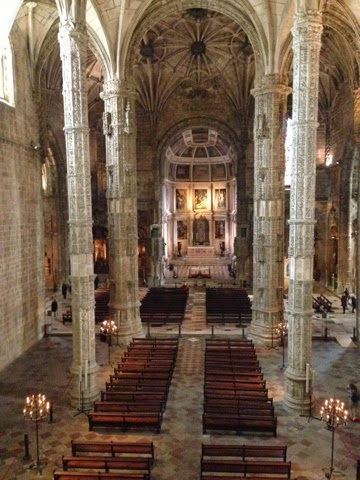King Manuel who ruled from 1495 erected this giant, white limestone church and monastery - which stretches 300 yards along the Lisbon waterfront - as a "thank you" for the discoveries made by Portuguese explorers. It was as I had mentioned in a previous blog financed in part with a "pepper money", a 5 percent tax on spices brought back from India. Manuel built the church on the site of a humble chapel where sailors spent their last night ashore in prayer.
We entered the church first which is on the right. Admission is free and we like to hold on to our money as long as possible - ha! The fancy portal facing the street, is textbook Manueline. Henry the Navigator stands between the doors with the king's patron saint, St Jerome ( above on the left with the lion. This door is only used when Mass lets out or for Saturday weddings.
The Manueline style is on the cusp of the Renaissance. So the interior of the church is more open than earlier medieval churched. Slender, palm tree-like columns don't break the interior space and the ceiling is all one height. Motifs from the sea hide in the decor. You see rope-ike arches, ships, and monsters that evoke the mystery of undiscovered lands. There are artichokes, eaten for their vitamin C to fend off scurvy,
You see elephants in some of the chapels. Elephants - the Oriental symbol of power, dethroned lions as the most powerful and kingly of beasts.
Parted with a little money and visisted the sacristy of the church. It was built betwen 1517 and 1520 according to the origina plan of the architect. The vault stems from a central column. The funiture includes a 16th century wooden chest where church vestments aqre kept. The black anal has a collection of 14 oil paintings by Samao Rodriques, representing scenes from the life of St. Jerome.
Return to the church.
Vasco da Gama's tomb
Across from his tomb is the tomb of another famous Portuguese poet -Luis Camoes.
We left the church, paid our money and entered the cloisters.
 The lacy arcade is Manueline; the simpler diamond and decorative rose frieze above the top floor is Renaissance. We loved studying the gargoyles looking for "creatures" . These are working rainspouts.
The lacy arcade is Manueline; the simpler diamond and decorative rose frieze above the top floor is Renaissance. We loved studying the gargoyles looking for "creatures" . These are working rainspouts.This is the small basin where the monks washed up before meals and marks the entrance to the refectory, or dining hall. Today an occasiona concert is held in this rooom. The room is lined with 18th century tiles and are considered textbok Rococo ( from the French word "shell".
Outside of the refectory is the burial spot of Portugal's most modern poet, Fernando Pessoa.
 Alexandre Herculano, a romantic 19th century poet and statesman is also buried here. There is a large exhibit in the cloisters telling Herculano's story. Very impressive individual.
Alexandre Herculano, a romantic 19th century poet and statesman is also buried here. There is a large exhibit in the cloisters telling Herculano's story. Very impressive individual. Quotes of Herculano adorn his tomb : "Sleep? Only the cold cadaver that doesn't feel sleeps. The soul flies and wraps itself around the feet of the All-Powerful,"
Heads of state are often received in the cloisters and it is also the site of many important treaty signings, such as Portugal's admittance to the European Union in 1986.
Time for us to leave and get some lunch. We had thought we'd try a new place that Rick Steve's recommended in his book but the eating area was outside and I thought it was just a little chilly to do that so we ended up at the Pasteis de Belem where we had enjoyed a nice lunch the previous time we visited Belem. This time a big disappointment. We had orderd a slice of pizza and a puff pastry with ham and cheese. They came cold - not good. A table behind us got their food delivered cold and they just stared at it and sent it back to be warmed. Smart! We had to have a pasteis de belem for dessert and theyLuis Camoes did not disappoint. They also have the best cappuccino - filled with whipped cream. Love it!
A selfie taken at the bakery with my new device.
After lunch we headed to the Coach Museum. Next blog!



























































No comments :
Post a Comment